How to Do the Upright Row for More Upper Body Muscle
Most shoulder exercises involve pressing a weight overhead, while most back exercises involve pulling a weight toward your body. The upright row is a little bit of both. This unique vertical pulling exercise targets your shoulders as well as your upper back.
Credit: Benoit Daoust / Shutterstock
This movement forms the basis of the Olympic lifts and other vertical pulling variations. It’s versatile and can be performed nearly any tool including a barbell, EZ-curl bar, resistance bands, even one or two dumbbells or kettlebells.
The classic and most common movement is the standard barbell upright row. This allows you to build the most vertical strength and power while packing size onto your “yoke” — the trapezius, upper back, and shoulders. Here’s everything you need to know to thrive with this weightlifting staple.
How to Do the Upright Row
The upright row is a vertical pulling exercise, moving the weight from your waist to near your shoulders. This movement can simultaneously improve upper body coordination and power for sports performance, while building some beefy shoulders and upper back.
Step 1 — Nail Your Starting Position
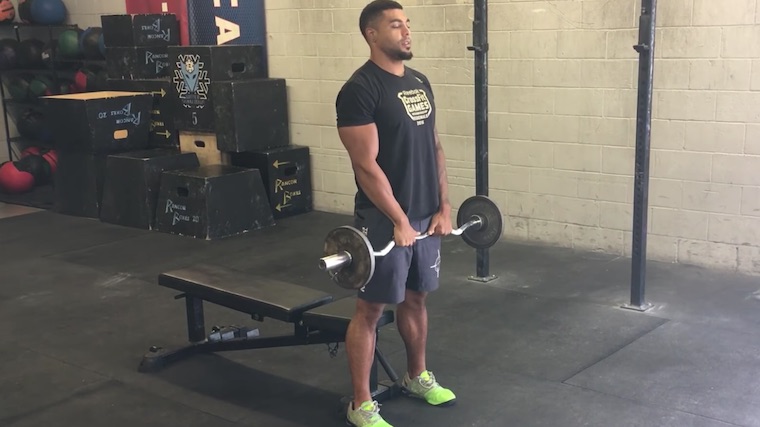
Stand up straight, holding a barbell with a shoulder-width grip at arm’s length. Drop your shoulders down, lift your chest up, and engage your glutes. Have your knuckles facing the ground and flex your thighs for the entire set. Tuck in your chin and keep a forward gaze to help maintain good posture throughout the entire set.
Form Tip: You can adjust your grip width to change the muscle recruitment. (1) A closer than shoulder-width grip will emphasize your front deltoids (shoulders). Lifting with a much wider grip will hit your upper traps harder.
Step 2 — Lead With Your Elbows
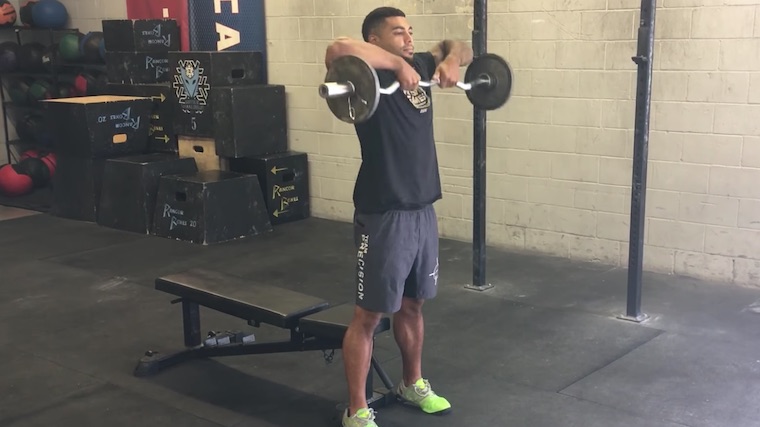
Bend your elbows and pull them up to shoulder-height. Keep the barbell close to your body and bring it up until you reach roughly chest-level. Maintain an upright torso and don’t let your hips swing the weight up. Keep your core, quads, and glutes engaged to keep a strong, stable posture. Squeeze your shoulder blades, trapezius, and shoulder muscles as you pause briefly in the top position. Don’t lean too far back when the weight is at the top.
Form Tip: In the top position, your elbows should be nearly level with your shoulders. Your wrists should be slightly below your shoulders, and the barbell should be below your wrists. This will help to keep your joints in strong and healthy positions.
Step 3 — Lower the Weight with Control
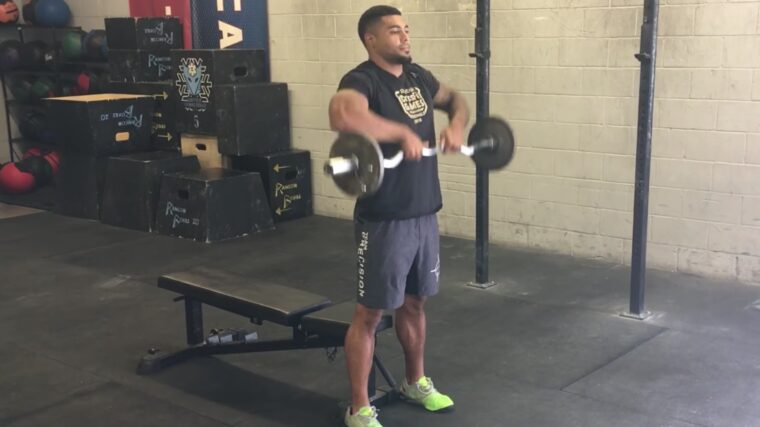
Keep the weight close to your body as you slide it back down toward the starting position. Grip the barbell tightly to maintain full control. When your arms are straight, pause and reset to ensure a good posture before doing the next rep.
Form Tip: Take three seconds to lower the barbell. This will help you control the eccentric (lower phase) and increase muscular tension for more growth.
Upright Row Mistakes to Avoid
The upright row may seem easy — you pull the barbell up and down your body and let the upper body gains begin. But, hang on, there is more than meets the eye here. Avoid these mistakes to get the most out of this exercise.
Lifting Too Heavy
As tempting as it is to load up an exercise to see how much you can lift, the upright row isn’t that exercise. It needs to be treated as an “accessory” to support your vertical pulls and to build muscle in your shoulders and upper back. It shouldn’t be trained for “absolute strength,” or the most amount of weight you can lift for a single repetition.
Trying to pull too much weight will encourage you to swing your body for momentum, which can strain your lower back. Excessively heavy weights can also stress your shoulder joints in the top position.
Avoid it: If you find yourself needing body English to pull the weight up, and if you cannot control the eccentric for two or three seconds, don’t be a hero. Lighten the load and lift with good form and proper control for better results.
Lifting Your Elbows Too High
Bringing your elbows higher than parallel to the floor may cause shoulder issues like impingement or bursitis when repeated over time. (2) Rather than driving your elbows up to your ears and trying to pull the bar to your neck, stop when your elbows have reached shoulder-level.
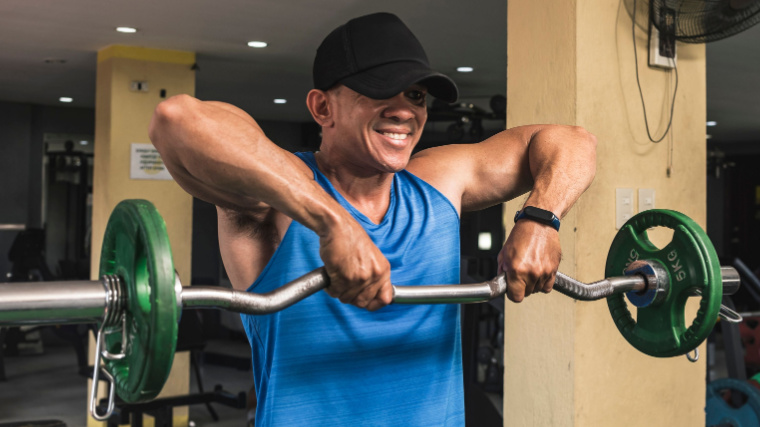
More range of motion is not better in this case because, as your elbows rise above shoulder-level, your shoulder joint is put into an awkward and potentially dangerous position as the smaller tissues within the joint capsule can be compressed and potentially damaged.
Avoid it: Pay attention to where your elbows are in relation to your shoulders. As you raise the weight, focus on reaching the appropriate height and not any farther.
Leaning Back
If you’re pushing the limits with too much load or trying (inefficiently) to create a longer range of motion, you may end up leaning too far back and extending your lower back while pulling the weight upwards.
When that happens, you lose good posture and put yourself at risk for a potential injury. You also add a “diagonal” movement to what should be a vertical pull, which changes your leverage and reduces the difficulty of the lift.
Avoid it: Keep your core tight, and engage your quads (thighs) and glutes for the entire set. When you lose that muscular engagement, end the set and consider lightening the load.
Letting The Bar Drift Away
If you get tired and begin using momentum to finish your set, or if you’ve got too much weight loaded, the barbell may drift away from your torso because you’re using too much body English and can’t maintain control over the bar.
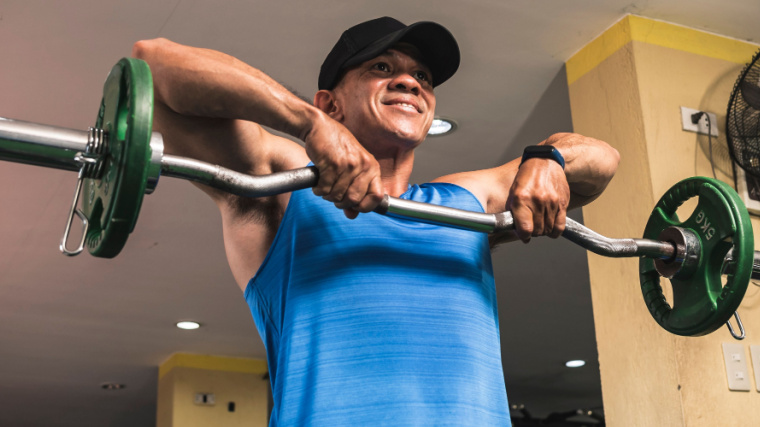
As the bar gets farther in front of your body, your smaller rotator cuffs are put under more stress, your wrist and elbow joints are put under more strain, and your overall leverage decreases which removes muscular activation from your upper back.
Avoid it: Keep your shoulders down and your chest up. This should help to recruit your shoulder and upper back muscles, which will help keep the barbell close to your torso as you lift and lower the weight.
How to Progress the Upright Row
The upright row may not always be the ideal movement for a vertical pulling exercise depending on your individual mobility. You may benefit from working up to the full barbell upright row. Here’s how to get started.
Two-Dumbbell Upright Row
The barbell can sometimes be unforgiving for lifters with existing wrist or elbow joint problems. A barbell also locks your hands into a fixed width and a position that may be uncomfortable for your current wrist or forearm mobility. Performing dumbbell upright rows is an excellent way to build size and strength while working around any mobility issues.
Dumbbells allow your hands and wrists to naturally rotate during the exercise, and this freedom of movement is more forgiving on your joints while still applying tension on the target muscles.
Tempo Upright Row
Every rep of every exercise technically has has four “parts” — the eccentric or lowering portion, the stretched position, the concentric or lifting portion, and the lockout or peak contraction. Manipulating how long each part takes is called tempo lifting, and it can be the key to getting more results from lighter weights.
For example, you might work with 3-1-2-3. This would mean you take three seconds to lower the weight, hold a one-second pause in the stretched position, lift the weight in two seconds, and pause for three full seconds in the contracted position. This puts the working muscles through more time under tension, and more time under tension leads to more growth. (3)
Unilateral Smith Machine Upright Row
While you can perform a single-arm dumbbell upright row, the weight can become problematic and unwieldy as the dumbbells get bigger and bulkier. This is an excellent time to turn to the Smith machine for an unconventional but highly effective movement.
With the fixed range of motion provided by the guided rails, the Smith machine provides extra stability. This allows you to go heavier than any dumbbell variation. The long barbell is also easier and more comfortable to grab than a relatively smaller dumbbell.
Benefits of the Upright Row
The upright row has excellent carryover to other vertical pulling movements like the snatch and clean & jerk. It’s also a great exercise to build a big “yoke” — the muscles across your shoulders and upper back.
Upper Body Muscle
Because the upright row works your deltoid muscles, upper back, and traps, bodybuilders and physique-focused lifters should include this exercise to train their entire shoulder area. It is an effective exercise for shoulder hypertrophy (growth), and building the “yoke” helps you look fit, muscular, and athletic even when you’re wearing a baggy sweatshirt.
Strength Carryover
If you’re a strength athlete involved in CrossFit or Olympic weightlifting, you are regularly performing lifts such as power cleans or high pulls. Training the upright row will have a direct carryover to the performance of these lifts because it trains the same muscle groups and supports overall development.
The upright row is also a good accessory exercise for Olympic weightlifting because it mimics the movement path of the snatch and clean. Although the full Olympic lifts train total-body power, the upright row helps to build the muscles involved, which helps to strengthen the entire movement.
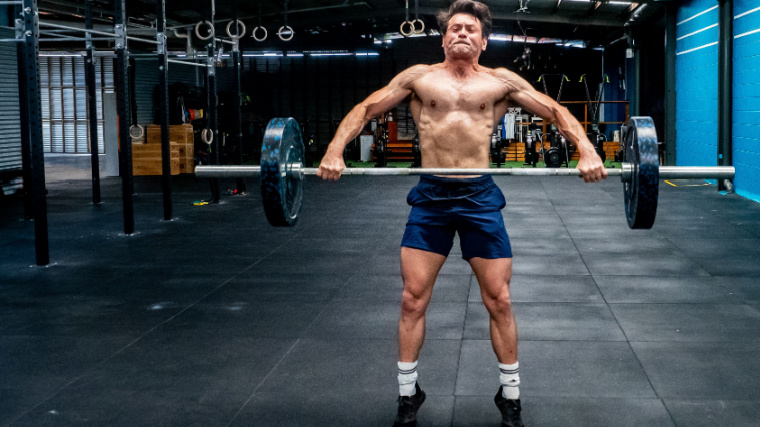
During the snatch and the clean & jerk, it’s essential to keep the barbell close to your torso when it travels at full speed. Doing the barbell upright row as an accessory exercise will improve the strength needed to keep the barbell close to your body.
Improved Posture
The barbell upright row targets the upper back and upper traps, which are essential for good posture. Improving postural strength has excellent carryover when keeping a neutral spine for barbell squats and deadlifts, or when simply walking in daily activity.
Improved Core Strength
The upright row is primarily an upper body exercise, so your anterior core (abs and hips) and posterior core (lower back and glutes) work hard to maintain a neutral posture. With the weight being in front of your body, your six-pack muscles are working hard so you don’t round forward or tilt sideways, while your posterior core ensures you don’t extend your lower back as you pull the load up toward your chest.
Muscles Worked by the Upright Row
The upright row is predominantly an upper body movement with your core and lower body muscles playing a supporting role. Here are the major muscles trained by the upright row.
Trapezius
The trapezius muscle’s primary function is controlling your shoulder blades, which occurs when pulling the barbell up. The scapulae (shoulder blades) outwardly rotate to pull the barbell up your torso. The vertical pulling motion of the upright row is in the trap’s wheelhouse.
Deltoids
All three heads of the deltoids — the front, side, and rear — are trained in shoulder abduction when your upper arm rises out to your sides. This is seen most significantly in the peak contraction at the top of the upright row.
Upper Back
The upper back (including your rhomboids and teres) plays two roles during the upright row. It controls the upward rotation of the scapula, as you reach the top part of the repetition, and it works to keep a good lifting posture with a neutral spine from top to bottom.
Biceps
Because your elbows bend and flex during the upright row, your biceps are also trained. However, they play a supportive role and aren’t the primary target. If your biceps are fatiguing before other muscles, adjust your grip width and focus on driving your elbows up — don’t overfocus on pulling with your hands.
Core
Your abdominals, obliques, and lower back work surround your torso to support your spine. This allows you to remain in a good overall posture so you can focus on the rest of the upper body muscles doing their job to move the weight.
How to Program the Upright Row
The upright row can be customized by adjusting sets and reps to suit your personal goals. The upright row cops some flack in lifting circles because it can put the shoulders in a potentially vulnerable position. But when the movement is programmed properly and performed correctly, it can be an extremely beneficial exercise with limited risk.
For Strength
Like many barbell exercises, the upright row can increase overall upper body strength. This is done by performing fewer reps and a few more sets at a relatively heavier weight. To focus on improving your upper back strength, perform three to five sets of four to six repetitions. However, the movement should remain strict and without any swinging. If you have to heave the weight up, you’ve gone too heavy.
For Performance
The barbell upright row can be performed when weightlifting athletes want to improve their bar path, coordination, and strength for Olympic lifts. When this is the case, use a moderate weight with a higher volume — three to four sets of 10 repetitions works well.
For Muscle
When looking to build your yoke, relatively higher reps with a light to moderate weight should be your go-to. This lets you emphasize your shoulders and upper back with higher volume to overload the tissue for better potential muscle growth. Here, anywhere from three to five sets of 10 to 15 repetitions works well.
Upright Row Variations
Although the barbell upright row is a great exercise to build your shoulders and upper back, it helps to have a few variations in your back pocket to pull out for variety, to reduce boredom, and to avoid overuse injuries. Here are three such variations.
Kettlebell Upright Row
The kettlebell upright row can be performed with one or two kettlebells. Holding one kettlebell with both hands doesn’t favor the shoulder joint, so either perform is with one weight in one hand or one weight in each hand.
Working unilaterally (a weight in each hand) can help strengthen imbalances between sides. The kettlebell also offers a different feel compared to a dumbbell because the weight’s center of gravity is lower. This can help to reinforce keeping the weight close to your body during the lift.
Snatch Pull
The snatch pull is an Olympic lift variation that trains lower- and upper body power. Because you’re driving the weight with your lower body, more weight can be used than with a strict upright row.
The snatch pull mimics a deadlift setup combined with the pulling part of the upright row, but using a wide snatch-grip will further strengthen your upper back. The explosive nature of the lift also helps to develop power and strength.
Single-Arm Upright Row
If you haven’t got access to a kettlebell, the single-arm upright row with a dumbbell is an effective and reliable variation.
The focus on unilateral strength will help strengthen each side of the body to improve overall bilateral performance. This is one of the most joint-friendly variations because you can easily adjust the range of motion and your hand position to your individual mobility needs.
FAQs
It’s perfectly fine if you’re unsure about the pros and cons of the upright barbell row, because it’s earned a slightly “controversial” reputation over the years — partly due to its demands on the shoulder joint, and partly due to lifters simply performing it incorrectly and negating its benefits.
Why do my wrists bend during the upright row?
Your wrist will flex or bend toward your body when the load gets heavy as you pull the weight up toward your chest. While some wrist flexion is okay at the end range of motion, you should reduce the weight if your wrists hurt.
The older lifters at the gym say the upright row will grind my shoulders into dust. Are they right?
The barbell upright row is not for everybody. Because the shoulders are internally rotated, a fixed range of motion and good shoulder mobility is required, and some will feel pain, particularly at the top of the lift.
If this is the case, perform kettlebell or dumbbell upright rows while improving your shoulder mobility. Work around the issue and not through it.
Know Your Row
The upright row is a time-tested movement for adding size to your shoulders, traps, and back and building pulling strength that carries over to almost every upper body exercise. It’s short-sighted to dismiss the upright row as simply being potentially dangerous. When performed with good technique, following proper programming, it can be a critical player in building a more muscular and more powerful upper body.
References
- McAllister, M. J., Schilling, B. K., Hammond, K. G., Weiss, L. W., & Farney, T. M. (2013). Effect of grip width on electromyographic activity during the upright row. Journal of strength and conditioning research, 27(1), 181–187. https://doi.org/10.1519/JSC.0b013e31824f23ad
- Schoenfeld, Brad MSc, CSCS1; Kolber, Morey J PT, PhD, CSCS2; Haimes, Jonathan E BS, CSCS2. The Upright Row: Implications for Preventing Subacromial Impingement. Strength and Conditioning Journal: October 2011 – Volume 33 – Issue 5 – p 25-28 doi: 10.1519/SSC.0b013e31822ec3e3
- Burd, N. A., Andrews, R. J., West, D. W., Little, J. P., Cochran, A. J., Hector, A. J., Cashaback, J. G., Gibala, M. J., Potvin, J. R., Baker, S. K., & Phillips, S. M. (2012). Muscle time under tension during resistance exercise stimulates differential muscle protein sub-fractional synthetic responses in men. The Journal of physiology, 590(2), 351–362. https://doi.org/10.1113/jphysiol.2011.221200
Featured Image: YAKOBCHUK VIACHESLAV / Shutterstock
Comments are closed.